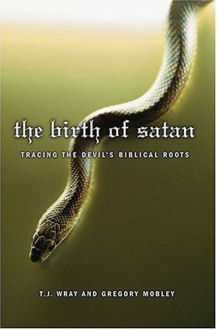
|
Posted October 1, 2005
Book: The Birth of Satan: Tracing the Devil’s Biblical Roots Authors: T.J. Wray and Gregory Mobley Palgrave Macmillan, New York, pp. 203 An Excerpt from the Jacket:
But how accurate are the popular images of Satan? Most people understand that the Satan we know and fear today originated in the pages of the Bible. What they may not know, however, is that he actually began as a rather low-level angelic figure in the Old Testament, and, even in the New Testament, he bears little resemblance to the horned devil of our nightmares. So how – and why – did this rather minor biblical character morph into the very embodiment of evil? T.J. Wray and Gregory Mobley guide readers on the journey to retrace Satan’s biblical roots, shedding light on the Devil’s slow and steady metamorphosis through the pages of holy writ, stopping along the way to explore the influences of other religious cultures and extra biblical writings that helped Satan assume his final form. An Excerpt from the Book: Satan in John The Gospel of John tells the story of Jesus’ life in terms of a cosmic battle between light and darkness, good and evil. Jesus is the cosmic redeemer who comes to earth to rescue the world from darkness and to cast out Satan, the “ruler of this world.” This cosmic war is similar to Essence scenarios about a battle between the “sons of darkness” and “the sons of light.” The situation of an embattled and fragile, post-resurrection (and post-Jewish War) community serves as the backdrop of the fourth Gospel. Their community’s struggle against an oppositional religious majority, the religious authorities who opposed their cause, is reflected in Jesus’ struggle with the evil ruler of this world who seeks to undermine his mission. The anonymous author of John was probably a convert to the Jesus movement who seems to share Luke’s conviction that “those who reject Jesus accomplish Satan’s work on earth.” John, like Luke, speaks of “the Jews” (John’s catch-all name for Jesus’ enemies) in unflattering terms. Confrontations between Jesus and “the Jews” occur on nearly every page of John’s Gospel. Jesus even accuses them of plotting to kill him: “Why are you looking for an opportunity to kill me, at which point his enemies accuse Jesus of paranoia, of being mentally ill, i.e., possessed by a demon: “The crowd answered, ‘You have a demon! Who is trying to kill you?” Much of John’s rhetoric against the Jews reflects the dire situation of his community in 90 to 100 C.E. This situation – which included a confrontation between John’s community and the Jewish majority – would lead to the group’s expulsion from the synagogues, an action that apparently traumatized the Johannine community (who still very much considered themselves Jewish), as reflected in several passages in John that refer to the expulsion. . . .John’s Jesus has some rather strong opinions concerning the true identity of his opponents, going so far as to identify them as the children of the Devil: . . . Does ths mean that Jesus understands the father of the Jews to be the Devil? Of course not. But it does mean that, for John, anyone who opposes Jesus’ mission – whether the audience in the scene we just mentioned, or Judas, or even Peter himself – is acting as a tool of Satan. Table of Contents:1. The Bible and other preliminaires 2. Unsystematic theology: the nature of God in the Hebrew Bible 3. The Devil is in the details: Satan in the Hebrew Bible 4. The influence of Israel’s neighbors on the development of Satan 5. Satan between the Testaments 6. Sant in the New Testament 7. Hell: Satan’s home 8. Why Satan matters |
|
